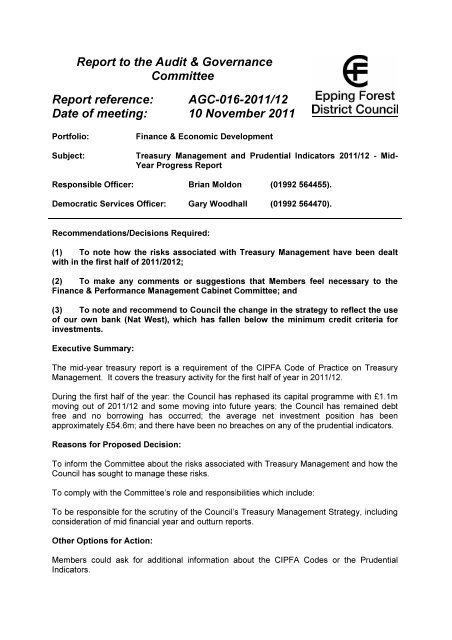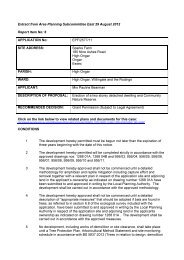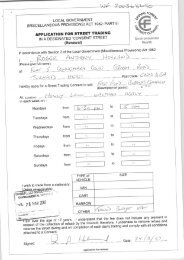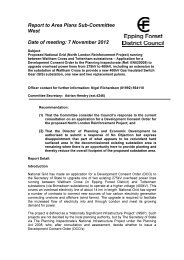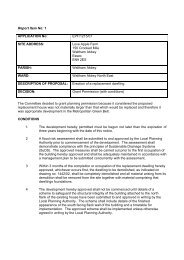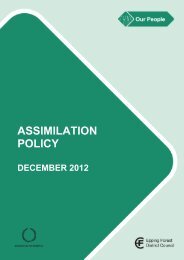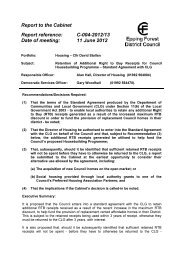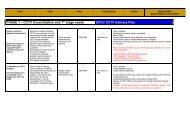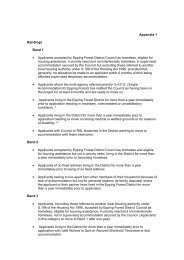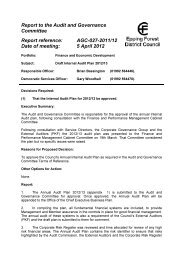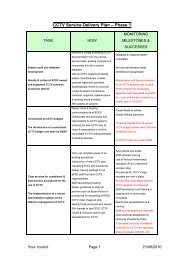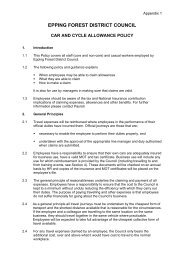Mid-Year Progress Report PDF 111 KB
Mid-Year Progress Report PDF 111 KB
Mid-Year Progress Report PDF 111 KB
Create successful ePaper yourself
Turn your PDF publications into a flip-book with our unique Google optimized e-Paper software.
<strong>Report</strong> to the Audit & GovernanceCommittee<strong>Report</strong> reference: AGC-016-2011/12Date of meeting: 10 November 2011Portfolio:Subject:Finance & Economic DevelopmentTreasury Management and Prudential Indicators 2011/12 - <strong>Mid</strong>-<strong>Year</strong> <strong>Progress</strong> <strong>Report</strong>Responsible Officer: Brian Moldon (01992 564455).Democratic Services Officer: Gary Woodhall (01992 564470).Recommendations/Decisions Required:(1) To note how the risks associated with Treasury Management have been dealtwith in the first half of 2011/2012;(2) To make any comments or suggestions that Members feel necessary to theFinance & Performance Management Cabinet Committee; and(3) To note and recommend to Council the change in the strategy to reflect the useof our own bank (Nat West), which has fallen below the minimum credit criteria forinvestments.Executive Summary:The mid-year treasury report is a requirement of the CIPFA Code of Practice on TreasuryManagement. It covers the treasury activity for the first half of year in 2011/12.During the first half of the year: the Council has rephased its capital programme with £1.1mmoving out of 2011/12 and some moving into future years; the Council has remained debtfree and no borrowing has occurred; the average net investment position has beenapproximately £54.6m; and there have been no breaches on any of the prudential indicators.Reasons for Proposed Decision:To inform the Committee about the risks associated with Treasury Management and how theCouncil has sought to manage these risks.To comply with the Committee’s role and responsibilities which include:To be responsible for the scrutiny of the Council’s Treasury Management Strategy, includingconsideration of mid financial year and outturn reports.Other Options for Action:Members could ask for additional information about the CIPFA Codes or the PrudentialIndicators.
<strong>Report</strong>:Introduction1. The Council’s treasury activities are strictly regulated by statutory requirements and aprofessional code of practice (the CIPFA Code of Practice on Treasury Management), whichincludes the requirement for determining a treasury strategy on the likely financing andinvestment activity for the current year. The updated code in November 2009 alsorecommended that Members are informed of Treasury Management activities at least twice ayear. This report therefore ensures this authority is embracing Best Practice in accordancewith CIPFA’s recommendations.2. The report attached at appendix 1 shows the mid-year position of the treasuryfunction in accordance with the revised CIPFA Treasury Management Code and the revisedPrudential Code.Capital Activity in the <strong>Year</strong>3. The Council undertakes capital expenditure on long-term assets. These activities mayeither be financed immediately through capital receipts, grants etc; or through borrowing.4. The Council does not plan to borrow in order to carry out its capital investment. Theoriginal estimate and probable outturn, along with the spend to month 6 (30 September 2011)is shown below in the table:Financial year 2011/12Capital ExpenditureEstimated Revised to month 6£m£m£mNon-HRA capital expenditure 6.431 5.278 0.683HRA capital expenditure 6.973 7.026 2.152Total Capital expenditure 13.404 12.304 2.835Financed by:Capital grants 0.658 1.229Capital receipts 5.801 4.054Revenue 6.945 7.021Total resources Applied 13.404 12.3045. The current probable outturn for 2011/12 shows a drop in capital expenditure of£1.1m, which has been partly re-phased into future years capital programme. This will meana reduction in the use of capital receipts in the current financial year of £1.75m, but increasesin the following year. This will result in a higher than anticipated level in reserves whencalculating potential investment interest for the current financial year.6. There is a financial risk involved in reducing the balance of usable capital receiptsover the next five years. This risk is included in the Council’s Corporate Risk Register (No.17) and identifies the following potential consequences; loss of interest; loss of cover forcontingencies; financial strategy becoming untenable in the long run; service reductionsrequired; and large Council Tax increases required.7. This prudential indicator assists the Council in controlling and monitoring the level ofusable capital receipts that will be available at the end of a five-year period. Currently, theCapital Programme for the next five years totals £46.4m and is fully funded. It is predictedthat at the end of 2015/16 there will still be £8.3m available in usable Capital Receipts and£14.7m in the Major Repairs Reserve. Therefore it can be concluded that adequate
esources exist for the Capital Programme in the medium term.The Impact on the Council’s Indebtedness for Capital Purposes8. The Council’s underlying need to borrow is called the Capital Financing Requirement(CFR). This figure is a gauge for the Council’s debt position. The Council currently does nothave an overall positive CFR (HRA and Non-HRA), and so has no underlying need to borrowfor capital purposes.Financial year 2011/12CFREstimated Revised to month 6£m£m£mNon-HRA 37.519 31.097 31.097HRA -38.303 -31.881 -31.881Total Capital expenditure -0.784 -0.784 -0.7849. The Director of Finance & ICT confirms that there were no breaches of the AuthorisedLimit (£5m), the Operational Boundary (£0.5m) and the Maturity Structure of Fixed RateBorrowing during the period to 30 September, with no borrowing undertaken within thisperiod.10. The risk for most Councils associated with this section relate to Refinancing – the riskthat maturing borrowings, capital project or partnership refinancing cannot be refinanced onsuitable terms. As the Council is debt free, there are not currently any risks relating torefinancing.11. These prudential indicators assist the Council in controlling the level of debt theCouncil may need to finance over the coming years and ensures where debt is owed it ismanaged, whereby the Council would not be left in a situation where it finds itself having torefinance on unsuitable terms.The Council’s Treasury Position12. During the first half of 2011/12 the treasury function managed the debt position toremain debt-free, in accordance with Council policy. The average investment position for thefirst half of the year was £54.6m. The table below shows the treasury position as at 30September 2011.Treasury position31/03/2011 30/09/2011£m£mTotal external borrowing 0.0 0.0Short term investment Fixed investment43.803 44.545 Variable investment 7.733 5.356Long term investment 0.439 0.439Debt from other Authorities 0.481 0.481Total investments 52.456 50.821(Net Borrowing) /Net Investment Position52.456 50.82113. It is important that the cash flow of the Council is carefully monitored and controlled toensure enough funds are available each day to cover its outgoings. This will become moredifficult as the Council uses up capital receipts and reduces investment balances.
14. The Director of Finance & ICT confirms that there have been no breaches of:(a) The Upper Limit for Fixed Rate Exposure (100%) and Upper Limit for Variable RateExposure (50%) during the period, with the average rates of 79.68% and 20.32% beingachieved;(b) The limit set for investment over 364 days (£30m). We made one investment of £5mfor 438 days. The average investment for the period is 160 days; and(c) The limit set for investment in non UK Country (30%).15. The risks associated to this section are as follows:(a) Credit and Counterparty Risk – the risk of failure by a third party to meet itscontractual obligations to the Council, i.e. goes into liquidation. The Council’s counter-partylists and limits reflect a prudent attitude towards organisations with which funds may bedeposited and these are regularly updated by our treasury advisors.(b) Liquidity Risk – the risk that cash will not be available when it is needed, incurringadditional unbudgeted costs for short-term loans. The Director of Finance & ICT has monthlytreasury meetings with treasury staff, to go through the cash flow for the coming month. Anumber of instant access accounts are used to ensure adequate cash remains available.(c) Interest Rate Risk – the risk of fluctuations in interest rates. The Council has currentlyaround 20% of its investments in variable rates, and the remainder are in fixed rate depositson average for around 197 days. This allows the Council to receive reasonable rates, whilstat the same time, gives the Council flexibility to take advantage of any changes in interestrates. The view of the Council’s treasury advisors is that interest rates are unlikely to changesignificantly in the short to medium term.16. The prudential indicators within this section assist the Council to reduce the risk of:(a) counterparties going into liquidation by ensuring only highly rated institutions are usedwhen investing the Council’s money;(b) the Council incurring unbudgeted short-term loans, to pay unexpected expenditureitems through ensuring adequate level of money are available immediately through instantaccess accounts; and(c) potentially losing out on investment income when interest rates start to increase byensuring that deposits are kept within one year.17. On 7 October, the Council received notification from Arlingclose that following theconclusion of the Moody’s review of UK Financial Institutions, Nationwide Building Society,Nat West Bank and Royal Bank of Scotland Bank Plc no longer met our minimum criteria andtherefore we currently can not undertake any new investments with them.18. As Nat West is the Council’s banker, although it does not meet the minimum creditcriteria of A+ (or equivalent) long term, it is proposed that Council gives approval that we willstill use them for short term liquidity requirements (overnight and weekend investments) andbusiness continuity arrangements. This will need to be classed as a non-specified investmentas it does not meet the ‘high credit quality’ as determined by the Council, in its TreasuryManagement Strategy Statement.
Heritable Bank19. During the first half of this financial year, the Council has received further dividends of10.37% (£258,793) from the administrators of the Heritable Bank. The latest administratorsreport indicates that a further dividend is due in October 2011, ultimately it is expected thattotal dividends will be around 90% of the value of deposits.Housing Finance Reform20. The PWLB has historically been the cheapest source of borrowing for localauthorities. However, the Chancellor of the Exchequer increased the margin charged by thePWLB in October 2010 and it appeared that cheaper sources of finance may have existed.Indicative pricing for ten year loans showed a PWLB interest rate of 4.4% compared to a tenyear bond at 4% and a private placement between 4 and 4.25%.21. To give the Council the best chance of securing the necessary borrowing at the mostfavourable rate Cabinet decided on 18 July 2011 to obtain a credit rating. This decisionfollowed informal discussions with several merchant banks and advice from the Council’streasury management advisers, Arlingclose. Following from this decision a Member panelinterviewed Moody’s and Standard & Poor’s and decided to appoint Moody’s to provide acredit rating.22. On 19 September 2011 it was announced, without any prior indication, that for selffinancing transactions PWLB rates would revert to their pre-October 2010 rates. This reducesthe rates by approximately 0.85% to leave the margin over gilts at approximately 0.15%. Thelargest saving against post-October 2010 PWLB rates that any of the alternative providers offinance had suggested as being possible was approximately 0.4%. This means that the newPWLB rates will undercut private financing opportunities by around 0.5%. Therefore, PWLBclearly offers the cheapest financing and as PWLB offers the same rates regardless of creditratings there is little to be gained from proceeding with the rating process. Given thesechanged circumstances, on 24 October Cabinet decided not to obtain a credit rating.Resource Implications:The continued low interest rate will result in estimated investment income to the Council tocontinue around £670,000 in 2011/12.Legal and Governance Implications:The Council’s treasury management activities are regulated by a variety of professionalcodes, statutes and guidance:• The Local Government Act 2003 (the Act), which provides the powers to borrow andinvest as well as providing controls and limits on this activity;• The Act permits the Secretary of State to set limits either on the Council or nationallyon all local authorities restricting the amount of borrowing which may be undertaken(although no restrictions were made in 2009/10);• Statutory Instrument (SI) 3146 2003, as amended, develops the controls and powerswithin the Act;• The SI requires the Council to undertake any borrowing activity with regard to theCIPFA Prudential Code for Capital Finance in Local Authorities;
• The SI also requires the Council to operate the overall treasury function with regard tothe CIPFA Code of Practice for Treasury Management in the Public Services;• Under the Act the ODPM (now DCLG) has issued Investment Guidance to structureand regulate the Council’s investment activities; and• Under section 238(2) of the Local Government and Public Involvement in Health Act2007 the Secretary of State has taken powers to issue guidance on accounting practices.Guidance on Minimum Revenue Provision was issued under this section on 8 November2007.Safer, Cleaner and Greener Implications:None.Consultation Undertaken:The Council’s external treasury advisors provided the framework for this report and haveconfirmed that the content satisfies all regulatory requirements.Background Papers:The report on the Council’s Prudential Indicators for 2011/12 to 2013/14 and the TreasuryManagement Strategy for 2011/12 went to Council on 22 February 2011 and amended atCouncil on 26 July 2011.The report on the Council’s Corporate Risk Register that went to Finance & PerformanceManagement Cabinet Committee on 20 June 2011.Impact Assessments:Risk ManagementAs detailed in the report, a risk averse position is adopted to minimise the chance of any lossof the capital invested by the Council. The specific risks associated with the different aspectsof the treasury management function have been outlined within the main report.Equality and DiversityDid the initial assessment of the proposals contained in this report forrelevance to the Council’s general equality duties, reveal any potentiallyadverse equality implications?Where equality implications were identified through the initial assessmentprocess, has a formal Equality Impact Assessment been undertaken?NoN/AWhat equality implications were identified through the Equality Impact Assessment process?N/A.How have the equality implications identified through the Equality Impact Assessment beenaddressed in this report in order to avoid discrimination against any particular group?N/A.


